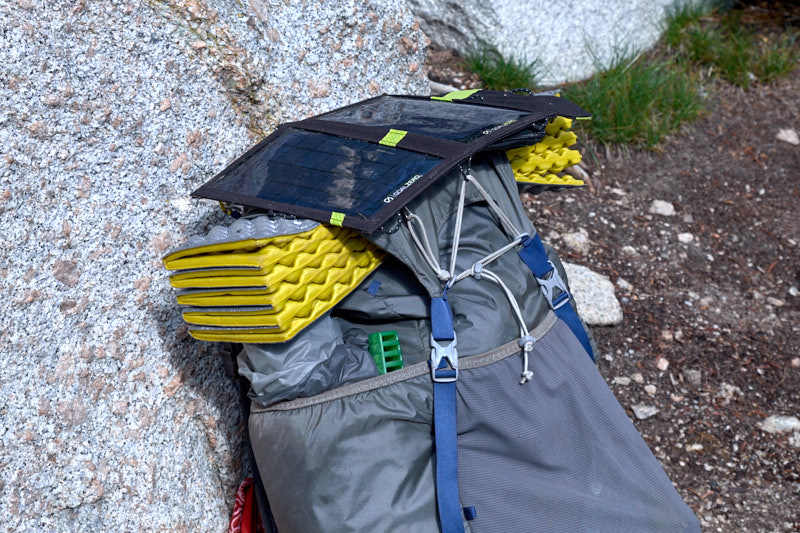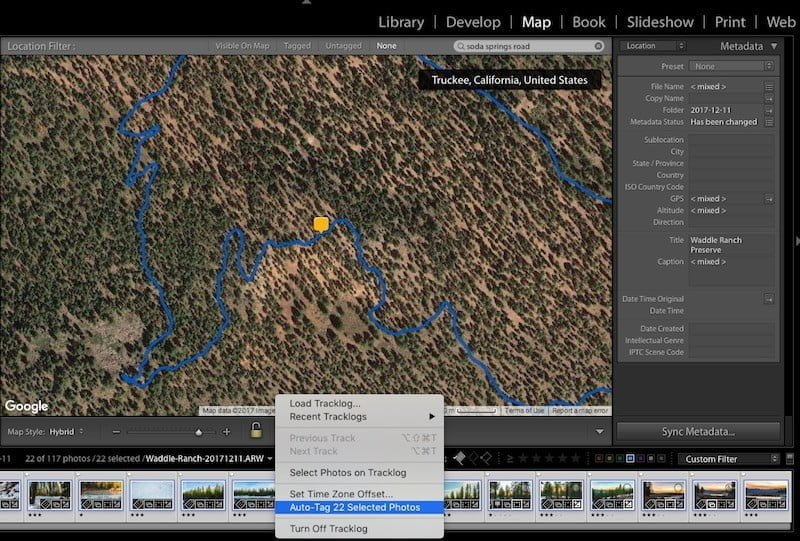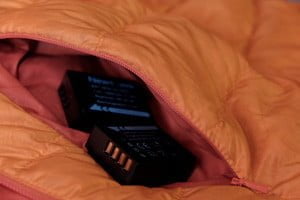Disclosure: This post may contain affiliate links. I earn a small commission of product sales to keep this website going.
Tips for getting your best mirrorless camera battery life
There’s nothing worse than watching the setting sun reflected in a small mountain lake, miles from civilization, and not having any juice left in the camera.
Here are a few tips on getting the most out of your mirrorless camera battery life while backpacking & traveling, part of my larger list of mirrorless camera photography tips.
While these battery-saving tips are intended for mirrorless cameras, you can also apply them to DSLRs.
Go Solar
This doesn’t really extend your mirrorless camera battery life, but it’ll ensure you don’t run out of juice.
Goal Zero makes some great portable solar charging solutions for photographers and their cameras. The Switch 10 alone as a portable battery pack will offer limited power, but when paired up with the Nomad 7 it’s unlimited.

Just make sure that the camera itself is covered in the shade! You can quickly fry the electronics if you leave it out in the sun next to the solar charger.
This will only really work with constant, direct sunlight – don’t expect it to charge in the shade of trees or clouds.
Turn off AutoFocus Assist
You know that little light in the front of the camera that turns on when you press the shutter halfway? That’s the autofocus illuminator, and it’s supposed to help the autofocus work its magic in dark scenes.
They only have an effective range of a few feet. And even then, today’s mirrorless cameras will temporarily boost the sensitivity to help with the focus. So autofocus assist isn’t really doing much for you except draining your battery.
USE Manual Focus
One of the best ways to get your camera’s best mirrorless camera battery life is to focus manually.
If you’re confident in your manual focusing abilities, use it. Let your fingers do the work instead of the servo motor. But if you do need autofocus…
Single Shot Autofocus (NOT CONTINUOUS)
Ensure you’re in single-shot autofocus (instead of continuous or servo) unless you’re doing fast-action sports (unlikely on the trail). Those modes will keep the autofocus motor running as long as you have the shutter pressed halfway, costing precious milliamps.
As long as you’re using single-shot autofocus, the motor will turn off as soon as it gets a lock.
Using back-button focus will also prevent the focus motor from churning on each shot.
Turn off Auto Review
The auto-review feature is nice, right? The LCD displays the photo you just took after each shutter click.
There’s actually a couple of reasons for turning this OFF, one being that if you keep checking out the photo you just took, you’re going to miss what’s happening in front of you.
But more importantly, you’ll notice a boost in your mirrorless camera battery life with this feature turned off. That display sucks up energy, and each time it displays your photo it’s just using more.
MINIMIZE Image Stabilization
The motors that keep the lenses or sensors stabilized use up a little bit of energy.
If you’re shooting with a fast shutter speed during daylight hours, there’s no reason to use this handy feature. Actually, if you’re using a tripod, you should have it off anyway.
So if you really want to make the best of your mirrorless camera battery life, turn it off unless you’re shooting handheld in low light and really need it.
WiFi & GPS

What kind of antennas does your camera have? Many have WiFi; we’ve yet to see mirrorless cameras with GPS but a lot of DSLRs have them.
Even though mirrorless cameras don’t have GPS built-in, several of them will connect to your phone via Bluetooth to tag the images with your phone’s location. This will decrease your battery life.
Switch your camera to Airplane Mode if you can, or manually turn off these energy-hogging features.
There’s a number of ways to know exactly where your photo was taken without having the locations automatically tagged. Use a Rite-In-The-Rain notepad to jot down your locations or switch your phone to Airplane Mode and record your GPS track using an app like Gaia GPS and then sync the GPS track to your photos in Lightroom when you get home.

Be Disciplined with the Shutter
Don’t press the shutter button, not even halfway, until you’re happy with your composition and ready to make the picture.
Not only will this save your mirrorless camera’s battery life, but it’ll also speed up your editing time later on with less mediocre photos to go through. Treat your memory card like film to not only save battery juice but to save time.

NO Flash

Does your camera automatically fire a flash for fill light? This is totally unnecessary if your subject is more than a few feet away, so turn the flash off.
You can always turn it back on when you’re taking a portrait and need a little fill light, but if you keep this on all the time it’ll fire unnecessarily.
USE THE EVF OR Dim the LCD
If you need the LCD to compose your shots (for cameras without viewfinders), turn it to the dimmest setting that you can. This may be impractical on bright days so you might want to turn it up, but don’t leave it full-bright all the time.
Many mirrorless cameras also have a setting that will turn off all displays unless it senses your eye in front of the electronic viewfinder (EVF), and then it will turn on the EVF. This is a great way to extend your mirrorless camera battery life since the displays only turn on when you’re composing a photo.
No Video!
Each frame, thirty to sixty per second, is a picture that needs to be processed and written to the memory card. Holy smokes there goes your battery.
PROPER Battery Storage
Cold weather really depletes your battery! Battery shrinkage, if you will.
In cold climates, you should be keeping your camera as close to the outside temperature as possible to prevent condensation and fogging, but your batteries should be swaddled in warm clothing.
Keep the spares warm, and take the active battery out of your camera and put it in your pocket when you’re not shooting.

Ration Your Usage
Approximately how many pictures can you take with one charge? 330? Ok, and how many days do you plan to be on the trail? Ten?
Subtract ten percent from your expected battery life as a reserve (you always want to save a little for the summit, right?). Ten percent of 330 is about 30, so that gives us 300 shots for our ten days. Now do the math, 300/10 is 30 shots per day. That’s all you get!
Carry a spare battery and double that. Two additional batteries? Now you get 90 in a day.
Carry Extra Batteries
Speaking of spare batteries…Wasabi Power makes affordable batteries and chargers that last as long as their brand-name counterparts, but for a fraction of the price. Buy a few and stuff them in your pack. If you know you’ll pass electricity at some point, you might be able to get away with carrying fewer batteries and a charger.
Even with a solar charger I still have a spare battery. Wasabi’s packs have never let me down for my GoPro, Sony, and Fujifilm cameras.
If you can spare the extra weight, a more significant portable battery pack like the Anker 20100 will get you dozens of charges.
What’d I miss?
Is there anything you do to make your mirrorless camera battery life last longer on the trail, vacation, or whatever else you’re doing far from the grid?

Ivor Lockhart
Saturday 8th of April 2023
One very simple power-saving practice is to turn off the camera when the photo is taken. It's unnecessary to keep the camera turned on all the time since it takes no time at all to power it up. I do this all the time with my Fujifilm X-T2. When I want to take a photo, I turn the camera on as I bring it to my eye. And a battery lasts for days before needing a charge.
Building your Fujifilm Photography Kit Part 3: Essential Accessories - DIY Photography
Tuesday 1st of March 2022
[…] And for more battery-saving tips, you can read this article all about increasing your battery life in mirrorless cameras. […]
lyn
Tuesday 14th of December 2021
Just bring a Juice Box! External Lithium battery pack that you can carry on your person and tether to the camera. Makes the OEM batteries on the Canon EOS RP look like a joke.
maxpatch67
Tuesday 10th of October 2017
Excellent information! Very useful! You mentioned condensation on the camera. I have problems with this as I usually carry it with s strap around my neck and it rests against my ribs as I hike.
John Peltier
Monday 16th of October 2017
I just started using the Peak Design Capture Clip - this keeps it secured in one spot against your shoulder straps. It may help a bit - I just like it because now my camera doesn't bang against everything!
Ashley Davidson-Fisher
Tuesday 7th of February 2017
The flash always kills it! I swear I can hear the flash on my Canon just sucking the life out of the camera! Thanks for the great tips. Wonderful post, as always!
John Peltier
Tuesday 7th of February 2017
Thanks Ashley - that's why I'll only buy cameras with external flash shoes now!